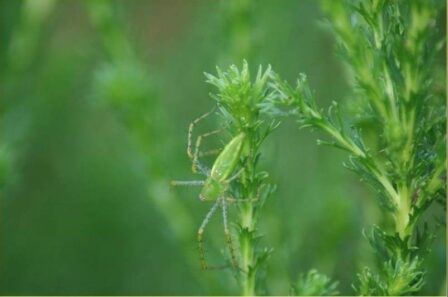Part 2 of Hidden in Plain Sight

The green lynx spider may be the most common spider in your garden. Photo courtesy of Meredith French of FrenchFoto.
During the Garden Club’s May meeting Master Gardener Meredith French covered a wealth of material regarding the insects of a healthy garden. Half of all living things are insects. There are over one million identified insect species, and scientists believe there may be as many as 20 million species that have yet to be unidentified. There are 26 orders of insects. Insects co-evolved with flowering plants. Insects have ectoskeletons, or skeletons outside their bodies. Insects and crustaceans have them. Insects’ bodies have three parts with six jointed legs and compound eyes. Most lay eggs. They either go through three stages: egg, nymph and adult, or they metamorphose. Is this a word? See dictionary-verb form.
Last month’s article dealt with lust and murder. This month we will look at family growth and relationships as well as how some these families use mimicry or camouflage for protection and predation.
French discussed the useful and interesting roles of wasps. Adults are pollinators but also predators. Depending on the species, some wasps seek and paralyze prey such as spiders or caterpillars to provide a food source for their eggs. Some are generalists, whereas others are quite specific in what food sources they seek. For instance, the blue mud wasp searches out black widows and their close relatives. All wasps deposit their eggs on or in the prey’s body cavity. Some, such as the tarantula hawk wasp will even keep its victim alive during this incubation and hatching process. They all are incredible mothers.
Another predator, the green lacewing, is a beautiful creature– essential for aphid control in your garden. Adults lay eggs on the undersides of leaves. Each egg when laid creates a pedestal on which to mature. This prevents the newly hatched and very voracious larval stage from eating each other. This is sibling rivalry at its height.
French’s favorite mom is the green lynx spider. She may be the most common spider in your garden and is well camouflaged in green with a pretty chevron on her upper abdomen. Meredith admires her protective and tenacious maternal behavior. After preparing a protective nesting site of disjointed web and bits of debris for her soon to be spiderlings, she lays from 25 to 600 eggs once or twice a season. These she encases in a protective shell resembling a walnut shell with one flat side. As it hardens, the eggs are protected from predators and physical jostling. She remains with the shell for the two week or more incubation period before their hatching. Neither inclement weather nor the unwanted predator or interloper will lure her from her post. She remains ever faithful to her role as mother. Her newly arrived babies instinctively disappear behind Mom’s back when danger appears. Mom stays with the babies until they are totally self-sufficient.
Perhaps the most unusual form of reproduction and motherhood is that of aphids. California is home to 450 species of them. The bright colored ones are generally poisonous to predators. It is strictly non sexual with females cloning themselves. Each generation spans just 10 days. When food is scarce, winged offspring are produced to move the colony. Males only appear when the colony is threatened by a virus. A few become soldiers who have “piercing beaks and strong legs to protect the tribe” when predators pose a real threat.
The greatest predator of the aphid is the beautiful and extremely important Hover or Syrphid fly which resembles a very small wasp. Its larvae are aphid-eating monsters that are undeterred by even the poisonous varieties. These flies do not sting and are of great value in your garden.
One of the ways many insects protect and procure food for themselves is through mimicry or camouflage. French gave several examples of mimicry. The larval form of the giant swallowtail butterfly looks much like bird poop. Birds and wasps will ignore it.
Mealy bug destroyer larva, one species of ladybug, resembles cotton because its prey, the mealy bug, looks like tufts of cotton. This larva eats mealy bug, but apparently mealy bugs’ camouflage makes the creature nearly invisible in its normal habitat.
French showed photographs of the goldenrod crab spider. It was almost impossible to see. Some crab spiders can change color, depending on the species, to blend with their surroundings, albeit slowly. Their mode of predation is to remain very still and then suddenly grab their prey. Green stink bugs resemble leaves and are extremely difficult to discern. If camouflage fails to ward off his prey, this creature ejects a fluid which truly stinks.
If you are interested in hiring Meredith French as a speaker or as a photographer, please email her at FrenchFoto@cox.net. She also teaches photography. She is truly a renaissance woman.
September’s meeting will feature a speaker from the Water Department talking about available programs for water conservation and what we should expect if the drought continues. Meetings take place from 6 to 8 p.m. at the church at 4070 Jackdaw.
Category: Events







